Finding sustainable alternatives to single-use plastics feels like a constant battle. You know your customers want greener options, but navigating the world of eco-friendly materials is complex, and choosing the wrong one can hurt your brand and the planet. You need a solution that is genuinely sustainable, safe for customers, and commercially viable for your business.
Bamboo tableware is a leading driver of this change because it offers a unique combination of sustainability, functionality, and aesthetic appeal. In 2023, the global bamboo tableware market hit approximately $3.21 billion, fueled by its fast-growing, renewable nature and its ability to biodegrade. For businesses seeking a reliable and attractive plastic alternative that resonates with eco-conscious consumers, bamboo is proving to be one of the most effective solutions available today, with a projected annual growth rate of 5.9%.
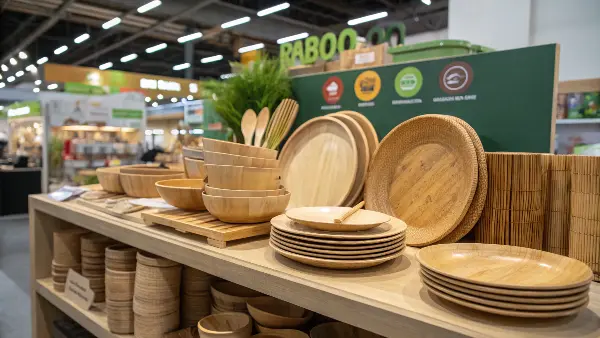
As a B2B supplier, we’ve had a front-row seat to this incredible shift. We talk to packaging specialists and product buyers like you every single day, and the conversation consistently turns toward bamboo. It’s more than just a trend; it’s a fundamental change in how businesses approach their environmental responsibility. But with this popularity comes a lot of questions. Is it truly better for the environment? Is it safe? Can it be customized for my brand? We’re here to break it all down and give you the clear, practical answers you need to make the best decision for your business.
Let’s dive into the specifics of why bamboo is becoming the go-to material in the eco-friendly tableware space.
Why Has Bamboo Tableware Become So Popular with Consumers?
You see "eco-friendly" labels everywhere, but your customers are getting smarter and more skeptical. They’re looking past the buzzwords for products that are genuinely sustainable, not just greenwashed. This puts immense pressure on you to find materials that not only perform well but also have a story of sustainability that holds up to scrutiny. A wrong choice could lead to customer mistrust.
Bamboo’s popularity stems from its powerful and easily understood eco-credentials combined with a natural, aesthetically pleasing look. Consumers are drawn to it because it grows incredibly fast without needing pesticides, making it a highly renewable resource. Unlike plastic, it’s biodegradable and compostable. This simple, compelling story of a plant-based alternative that returns to the earth resonates strongly with people who are actively trying to reduce their plastic footprint in their daily lives.
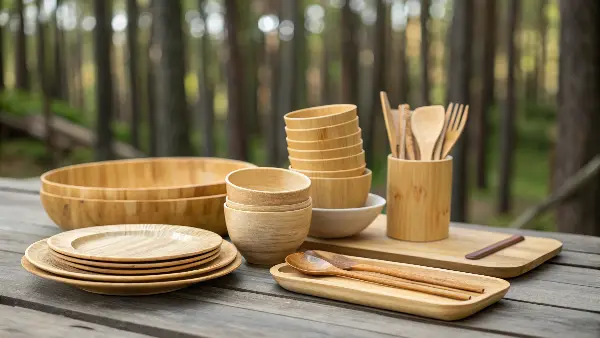
The rise of bamboo isn’t just a coincidence; it’s a direct response to a more educated and environmentally aware consumer base. We’ve seen this shift firsthand in the inquiries we receive. A few years ago, the focus was purely on cost and function. Now, the first questions are almost always about sustainability and origin. The "Blue Planet effect" has made a powerful impact, making images of plastic-choked oceans unforgettable. Consumers carry this imagery with them when they shop, and they actively seek out alternatives that make them feel like part of the solution.
Bamboo fits this role perfectly. Its warm, natural aesthetic stands in stark contrast to sterile plastic. It feels premium and earthy, elevating the dining experience whether at a picnic, a food truck, or a catered event. Social media has amplified this, with influencers and eco-conscious communities showcasing beautiful tablescapes featuring bamboo products. This visual appeal is a massive driver. A product that looks good and does good is a powerful combination. For you as a buyer, this means bamboo isn’t just a sustainable choice; it’s a marketable one that aligns directly with modern consumer values.
Key Drivers of Bamboo’s Popularity
| Driver | Description | Impact on Your Business |
|---|---|---|
| Consumer Awareness | Growing public knowledge of plastic pollution crisis. | Increased demand for visibly sustainable products. |
| Aesthetic Appeal | Natural, warm, and premium look and feel. | Enhances brand image and customer experience. |
| Renewability Story | Bamboo is a fast-growing grass, not a slow-growing tree. | A simple and powerful marketing message. |
| Social Media Trends | Visually appealing for platforms like Instagram and Pinterest. | Organic marketing opportunities and brand alignment. |
What Are the Real Environmental Benefits of Bamboo Compared to Other Materials?
Choosing the "right" eco-material can feel like navigating a minefield. You hear conflicting reports about PLA, questions about the recyclability of certain papers, and the obvious problems with plastic. You need to be certain that the material you choose offers a clear and demonstrable environmental advantage. Your company’s credibility and sustainability goals depend on making an informed decision based on facts, not just marketing claims.
Bamboo’s primary environmental advantage is its status as a highly renewable resource that requires minimal intervention to grow. It’s a type of grass that can grow to full size in just 3-5 years, compared to decades for traditional hardwood trees. It requires no pesticides or fertilizers and self-regenerates from its own roots, preventing soil erosion. This rapid growth cycle and low-impact cultivation give it a significantly smaller environmental footprint from the very start, even before considering its end-of-life biodegradability.
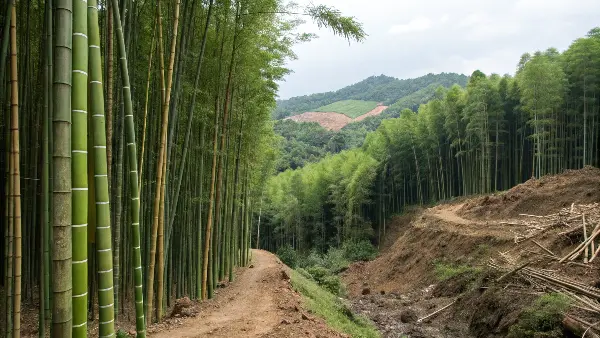
When we get into the details, bamboo’s benefits become even clearer, especially when you compare it directly to other common materials. Let’s look at the full lifecycle. The cultivation process is where bamboo first pulls ahead. As a fast-growing grass, it naturally sequesters a high amount of CO2 from the atmosphere. Unlike many commercial crops, it doesn’t require vast amounts of water to thrive.
Then there’s the manufacturing process. Turning bamboo into tableware is primarily a physical process of heating, pressing, and shaping. This is often less energy-intensive than synthesizing plastic polymers from petroleum or the complex processing required for some bioplastics. We work closely with our manufacturing partners to ensure these processes are as efficient as possible.
Finally, the end-of-life scenario is a huge selling point. A bamboo plate or fork can break down in a commercial composting facility in a few months, returning nutrients to the soil. This contrasts sharply with plastic, which persists for centuries, and even some other materials that can only be composted under very specific industrial conditions that aren’t widely available. For a business, this full-circle story—from a fast-growing plant back to the earth—is not only environmentally superior but also incredibly compelling for your customers.
Material Comparison: Bamboo vs. Plastic vs. PLA
| Feature | Bamboo | Conventional Plastic (PS, PP) | PLA (Bioplastic) |
|---|---|---|---|
| Source | Plant (Grass) | Fossil Fuels (Petroleum) | Plant (Cornstarch, Sugarcane) |
| Renewability | Highly Renewable (3-5 years) | Non-Renewable | Renewable (Annual Crop) |
| Growth Impact | Low water use, no pesticides | Environmentally costly extraction | Industrial agriculture, uses pesticides |
| End-of-Life | Biodegradable, Compostable | Landfill/Ocean (450+ years) | Industrially Compostable Only |
| Carbon Footprint | Carbon negative during growth | High carbon emissions | Lower than plastic, but has a footprint |
How Can You Ensure Bamboo Tableware is Safe and Compliant?
Sourcing from overseas introduces a layer of uncertainty. When it comes to food-contact products, you can’t afford any risks. Your customers trust your brand to provide products that are 100% safe. You worry about hidden chemicals, unsafe manufacturing practices, and whether a product that claims to be "natural" is actually compliant with strict North American or European standards like FDA and LFGB. A compliance failure could be devastating.
The key is to work exclusively with suppliers who provide comprehensive, up-to-date certification for food-contact safety. Look for internationally recognized standards like FDA (U.S. Food and Drug Administration) and LFGB (German Food and Commodities Act). These certifications guarantee that the tableware is free from harmful substances like heavy metals, phthalates, and formaldehyde. By demanding and verifying these documents, you shift the burden of proof to the supplier and ensure you are sourcing a verifiably safe product.

As a buyer, you need to be proactive. Never take a supplier’s word for it. Always ask for the test reports. At Ecosourcecn, we make this part of our standard process because we know how critical it is. When we provide you with a product, we also provide the full documentation proving its a compliance. An LFGB certification, for example, is one of the toughest standards globally. It ensures that the material won’t leach any chemicals or affect the taste or smell of food, which is a major concern with natural materials.
Another critical point to investigate is the adhesive or binder used, if any. Some lower-quality bamboo products are made from bamboo fibers held together with a melamine-formaldehyde resin. While this makes them durable and reusable, it renders them non-biodegradable and raises safety questions about chemical leaching, especially when heated. True single-use, compostable bamboo tableware should be made from 100% bamboo, typically by heat-pressing layers of bamboo veneer. Always clarify the composition with your supplier: ask "Is this 100% bamboo, or is it a composite material?" This single question can protect you from greenwashing and ensure you’re buying a product that is as eco-friendly and safe as it claims to be.
What Customization Options Can Elevate a Brand Using Bamboo?
In a competitive market, a standard, off-the-shelf product isn’t enough. You need your packaging and tableware to reflect your brand’s unique identity and commitment to quality. The question is, can a natural material like bamboo offer the same level of customization as traditional materials? You worry that you might have to sacrifice branding opportunities for sustainability, preventing your products from truly standing out on the shelf or at an event.
Bamboo offers a surprising range of customization options that can effectively showcase your brand. The most popular method is precision laser engraving, which burns your logo or design directly onto the surface of plates, cutlery, or stirrers for a sophisticated, rustic look. Beyond branding, you can also customize the product itself. We can work with you to create custom shapes and sizes for tableware or develop bespoke retail-ready packaging, such as branded kraft paper sleeves or boxes for cutlery sets.
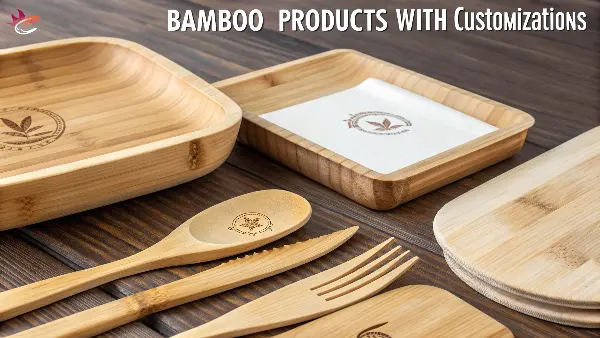
Think of bamboo as a blank canvas waiting for your brand’s story. We’ve helped clients move far beyond a simple logo. For one coffee chain, we developed a unique, longer coffee stirrer with their brand name engraved along the length. For a high-end catering company, we created a custom-molded, square bamboo plate that matched their modern aesthetic. The customization possibilities extend to the entire product experience.
Private label packaging is where you can truly differentiate. Instead of receiving products in bulk, we can design and produce retail packs for you. Imagine a beautifully designed cutlery set—a fork, knife, spoon, and napkin wrapped in a printed kraft paper sleeve—ready to be sold in stores or added to meal kits. This not only provides convenience for the end-user but also turns a simple disposable item into a powerful branding tool. It tells your customers that you’ve considered every detail of their experience, right down to the cutlery. By partnering with a supplier who has expertise in both the product and its packaging, you can create a cohesive, premium, and sustainable offering that sets you apart from the competition. This strategic approach turns a simple sourcing decision into a value-adding investment for your brand.
What Are the Potential Pitfalls When Sourcing Bamboo Tableware?
You’ve decided bamboo is the right direction, but you know that not all suppliers are created equal. Your biggest fear is unknowingly purchasing a low-quality or non-compliant product. Stories of "bamboo" products that are actually plastic composites, or tableware that splinters or fails, are a real concern. Making the wrong supplier choice could lead to defective products, customer complaints, and a major setback for your sustainability program. You need to know what to watch out for.
The most significant pitfall is the issue of bamboo composite materials, often sold as "bamboo" but actually made from bamboo fiber mixed with melamine or plastic binders. These products are not biodegradable or compostable and can mislead consumers. Another major pitfall is inconsistent quality, such as splintering or a lack of durability, which stems from poor raw material selection or improper manufacturing. To avoid this, you must demand 100% material composition disclosure and ask for product samples to test yourself.
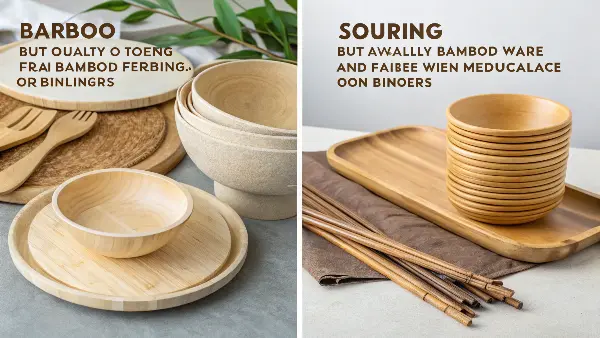
Let’s be very direct about the bamboo-melamine issue, as it’s the biggest trap for buyers. These products look and feel sturdy, and they are often marketed as "eco-friendly" because they contain bamboo. However, the presence of melamine resin means they will persist in a landfill just like plastic. A reputable supplier will be transparent about this. Always ask: "What percentage is bamboo, and what is the remaining percentage made of?" If the answer isn’t "100% bamboo," it’s not the single-use compostable product you’re looking for.
Quality control is the other battlefield. We’ve seen samples from other factories where the bamboo plates are too thin and crack under the weight of food, or where the forks have rough, unfinished edges that could splinter. This usually happens when a manufacturer cuts corners, using immature bamboo or rushing the heat-pressing process. The only way to protect your brand is through diligence. That’s why getting samples is non-negotiable. You need to feel the product. Test its strength, check for a smooth finish, and pour hot liquids on it. A good partner will understand and encourage this scrutiny. It shows you’re a serious buyer, and it gives them a chance to prove the quality of their products.
Conclusion
In short, bamboo tableware is reshaping the industry by offering a solution that meets consumer demand for sustainability, safety, and style. Its rapid renewability and biodegradability provide a clear environmental advantage. By focusing on certified suppliers and exploring customization options, your business can confidently adopt bamboo, strengthening your brand and making a real impact on reducing plastic waste.


